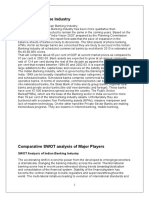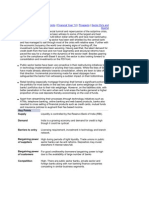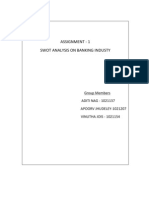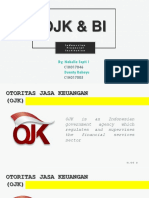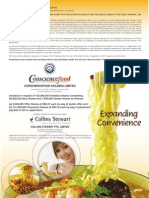Chinas Wholesale
Chinas Wholesale
Uploaded by
Navin RajagopalanCopyright:
Available Formats
Chinas Wholesale
Chinas Wholesale
Uploaded by
Navin RajagopalanCopyright
Available Formats
Share this document
Did you find this document useful?
Is this content inappropriate?
Copyright:
Available Formats
Chinas Wholesale
Chinas Wholesale
Uploaded by
Navin RajagopalanCopyright:
Available Formats
M A R C H 2 0 11
f i n a n c i a l
s e r v i c e s
p r a c t i c e
Chinas changing wholesale landscape
The right strategy is key to finding success in this growing market.
Yi Wang, Jun Xu, and Anna Yip
Mainland Chinas wholesale banking market is projected to grow at more than 10 percent per annum over the next five years. At that pace, it is set to overtake Japans as the largest in Asia by 2015. National development strategies, such as urbanization and industrialization, will continue to drive double-digit annual increases in the sectors assets and revenues. This said, the landscape is changing, and both local banks and their foreign-owned counterparts face a more challenging competitive and regulatory environment. Loan growth is slowing, margins on corporate lending are under pressure, nonperforming loans (NPL s) are on the rise, and new capital is needed to meet tougher capitaladequacy requirements.
In the future, all banks may therefore have to move a bit outside their comfort zone and target five attractive opportunities: a new age of infrastructure financing, untapped potential in relationship banking, better intermediation of capital flows, the neglected small-business sector, and the modernization of Chinas capital markets. Access to these opportunities is unequal, however, and will dictate different strategies. Local banks will need to move beyond their traditional corporate deposit and loan business into higher-margin products, grow their fee business, and control costs even more tightly. Foreign banks risk being marginalized if they do not find
Chinas changing wholesale landscape
sustainable sources of new growth. While some will choose to remain focused on high-margin and cross-border businesses, others will go deeper into the local market. With the right strategy, both sorts of bank can find success in Chinas burgeoning corporate and investment-banking (CIB) market.
retail operations, many are already generating double-digit returns on equity on their wholesale activities. Several important trends are now reshaping this benign landscape: The pace of loan growth is slowing. Corporate
The outlook for CIB Local and foreign players have adopted radically different strategies for their wholesale banking businessesand both have enjoyed considerable success. Local national banks, for example, have traditionally focused on high-volume, plain-vanilla lending products. They have benefited from Chinas unique corporate lending market, distinguished by the way it is funded with corporate and institutional deposits rather than retail deposits. (Total corporate and institutional deposits amounted to $5.1 trillion at the end of 2009, compared with $3.9 trillion of personal deposits.) This structure explains the banks relatively low cost-to-income ratios (35 percent to 40 percent for most national banks), and, combined with a very low loan-loss ratio (0.2 percent to 0.3 percent of assets at present), provided the ingredients for healthy margins and a highly profitable wholesale business in recent years. Foreign banks, meanwhile, with just 1.77 percent of total assets in Chinas banking market and a minute share of the local capital market activity, have concentrated on niche businesses, such as fixed income, currencies, and commodities (FICC) and international trade finance. These have been profitable. Notwithstanding the heavy investments they have made to build up their franchises in China and their mostly loss-making
lending growth averaged 20 percent per annum from 2006 to 2009, culminating in a stimulus-induced $1.5 trillion lending bonanza in 2009 (up almost a third on the previous year). Over the next five years, however (from 2011 to 2015), real annual GDP growth in China is expected to drop from an estimated 10 percent to 11 percent in 2010 to around 9 percent, a big factor in the projected slowdown of annual bank loan growth to around 13 percent. Margins will remain under pressure. With interest income still accounting for about 80 percent of the revenues of Chinese banks, interest margins are critical. Between late 2008 and early 2009, largely due to asymmetric rate adjustments by the Peoples Bank of China, the Chinese central bank, margins declined by 70 basis points, to about 230 basis points. While they have since recovered slightly, to around 240 basis points, we do not expect them to move up any further. NPL s are on the rise. NPL ratios have been on a decade-long decline, thanks to better risk management and the impact of rapid loan growth. With slower loan growth, on the other hand, the NPL ratio will likely rise steadily for most banks, even if loan quality during the stimulus-induced boom of 2009 turns out to be the same as in preceding years a generous assumption.
March 2011
Regulatory pressure is intensifying. The China Banking Regulatory Commission (CBRC) has been raising standards for banks, in line with global best practice. It has increased the capital-adequacy ratio to 7 percent for core assets and 11.5 percent for total assets for state-owned banks, and it intends to raise it to 10 percent for total assets for joint-stock banks. Banks have already raised substantial amounts of new equity and subordinated debt from the market ($46 billion as of July 2010), but this is well short of the need, which some estimates put at $80 billion.
per year. Investment banking, while much smaller, will grow more rapidly, at 15 percent per year over this period. Sales and trading, still dominated by retail brokerage, is likely to see continued volatility and is expected to grow more slowly, at 5 percent per year. Should this scenario play out, mainland China will overtake Japan to become the largest wholesale banking market in Asia by 2015. Profitable growth opportunities Tapping this impressive potential will require banks to strategically target five business opportunities. Some will be more attractive to local banks; others will appeal more to foreigners.
MoCIB111 2010 Exhibit shows a likely scenario for the growth of China banking revenue in China over the wholesale Exhibitfive years. Despite the slower loan growth, coming 1 of 4
total revenue is still likely to grow at 9 percent
Exhibit 1
Corporate and investment banking in China is set for continued growth.
China wholesale banking revenue pools, RMB billion
+9% per year
3,291 CAGR,1 200915, % 3,038 Corporate banking 9
2,536 1,957 2,328 1,784 24 150 20092 36 172 2012 55 197 20152 Investment banking Sales and trading
15 5
1 Compound 2 Figures
annual growth rate. do not sum to totals, because of rounding.
Chinas changing wholesale landscape
Fixed-asset investment, driven by increasing urbanization, is expected to remain the top contributor to GDP over the next five years.
Infrastructure financing New policies have been devised in China in an effort to boost consumption. But fixed-asset investment, driven by increasing urbanization, is expected to remain the top contributor to GDP over the next five years. Between 2010 and 2015, about $10 trillion of urbanization-related infrastructure investment will be required. The large national banks funding much of the recent infrastructure expansion are deepening their expertise, a trend we expect to continue as others go beyond a purely relationshipdriven approach. China Industrial Bank, the countrys tenthlargest local bank, for example, worked closely with the International Finance Corporation to build an energy-efficiency lending program. Key innovations included new approaches to risk sharing, minimal or no collateral requirements, and repayment terms tied to energyefficiency savings. Two phases are complete, total lending now exceeds $330 million, and none of the loans has gone bad. This expertise has enabled the partners to build real competence and competitive strengths and to capture other lending opportunities in this area. Primary relationships through transaction banking The domestic transaction banking market has remained relatively undifferentiated, with leading state-owned banks dominating the market. As has been the case in many Western Integrating domestic supply chains. Local banks are already building capabilities to integrate the end-to-end financial needs of supply chains. These more sophisticated solutions optimize the use of cash and working capital along the value chain, allowing banks to develop a much better view of the credit risks they are taking. Shenzhen Development Bank, for example, has built capabilities in key industry verticals, such as trading, manufacturing, and automotives. Managing cash. China has the highest corporate deposit-to- GDP ratio globally among large economies, with 56 percent of bank deposits coming from corporate customers. Traditional, relationship-based corporate deposit gathering is likely to remain the norm but more sophisticated corporate chief financial officers and treasurers will increasingly demand advanced cash-management services. Cash-management systems and capabilities will be a priority for all banks aiming to develop primary banking relationships. China Merchants Bank (CMB) developed its cashmanagement business over six years and now manages around $100 billion, or twothirds of its total corporate deposit base. and Asian markets, however, transaction capabilities will be a key success factor in domestic commercial banking. A few opportunities warrant particular attention:
March 2011
The intermediation of corporate trade and investment flows We see several opportunities where banks can direct such traditional services as trade finance,
M&A advisory, and product development.
Small-business growth Small businesses are a key engine of Chinas economic growth, accounting for 44 percent of employment and 35 percent of GDP. Yet as Exhibit 2 demonstrates, they represented only 17 percent of banks assets in 2008. Our research shows that although 70 percent of small businesses currently borrow money, the banks fail to meet almost half of their financing needs. Moreover, the CBRC is encouraging banks of all sizes to increase their exposure to small businesses. The potential here is not just to grow this business but to increase loan yields at a time when margins are under pressure.
Fund Chinas import-export engine. In 2009, Chinas trade with the world stood at $2.2 trillion. Intra-Asia trade in particular is becoming increasingly important, especially the critical triangle trade flow between mainland China, Hong Kong, and Taiwan. Support international expansion. In 2009 alone, Chinese enterprises spent $30 billion on overseas M&A . While much current overseas acquisition focuses on natural resources, corporate M&A , like that of Geelys acquisition of Volvo, will gather momentum. Facilitate the internationalization of the renminbi (RMB). A series of new policies aimed at accelerating the internationalization of the RMB were unveiled this year, expanding the year-old pilot program to companies in all countries and from 5 Chinese cities to 20 provinces. Any company in the world can open an RMB bank account in Hong Kong and exchange RMB as it pleases. This liberalization has already provided the impetus for a rash of new RMB -denominated financial products in the Hong Kong market, including the landmark Hopewell Highway Infrastructures first nonbank RMB -denominated bond. This is a strategically important opportunity for foreign banks, particularly those with a strong presence in Hong Kong. However, for domestic banks, this remains quite small compared with domestic RMB opportunities.
Research we carried out jointly with the CBRC in 2009 identified three main characteristics of winning models in small-business lending. First, while banks generally start with secured or asset-based lending, they enhance pricing by reducing collateral requirements over time. Second, they attract deposits so as to make this business partially self-funding. Third, they capture synergies by combining lending with the provision of retail financial services to smallbusiness owners and their employees. China Minsheng Bank, the countrys ninth-largest local bank, for example, recently launched a smallbusiness lending program using personal assets as collateral. The balance-sheet value of this activity had exceeded $15 billion by August 2010, one year after its launch, and thanks to better pricing, the bank also significantly boosted margins and loan yields. Modern capital markets Chinas financial stock has risen sharply, reaching 336 percent of GDP in 2009, and it is approaching the US level of 415 percent. However, as Exhibit 3 shows, key capital market products, such as debt capital markets (DCM)
Chinas changing wholesale landscape
MoCIB 11 2010 China Exhibit 2 of 4
Exhibit 2
Small enterprises dominate the Chinese economy, but they are underserved by corporate banks.
Corporate components of Chinas economy,1 2009, % RMB 33.5 trillion 35 61 30 44 Number of enterprises Number employed3 22 35 GDP3 17 Bank loan 30 GDP Bank loan 55 70 RMB 34.4 trillion Benchmark Taiwan, 2006
100% = ~5.1 million 2 Large enterprises 10 2 Midsize enterprises
770 million 23 33
45
Small enterprises2
88
MoCIB 11 2010 China individual proprietors. Loans to individuals are classied as personal business loans rather than corporate loans. 2The denition of small and midsize enterprises is taken from Provision of the criteria of SMEs, issued by four Chinese ministries. 3Exhibit 3 of 4 Excludes small industrial enterprises; this denition is taken from the China Statistical Yearbook.
1 Excludes
Source: China Banking Regulatory Commission; China Statistical Yearbook; McKinsey analysis
Exhibit 3
Many products have considerable scope for further growth.
Selected wholesale banking products, 2008, volume as % of GDP Corporate lending China Hong Kong Taiwan Korea United States Germany
1 Bank
Debt capital markets 83.2 110.4 1.6 2.6 3.0 6.9 9.6
Foreign exchange (FX)1 0.2 81.1 3.7 3.6 4.7 2.7
Rates2 78.4 1,901.8 227.6 323.8 2,859.9 860.1
63.5 50.6 16.8 54.7
10.1
2Proxy
for International Settlements (BIS) FX Turnover Triennial Survey, 2007. by government bonds and rate derivatives trading.
Source: BIS; World Federation of Exchanges; McKinsey Global Banking Pool; McKinsey Asia trade nance model
March 2011
and rates-based trading, have barely caught on. By 2012, we estimate that total revenue from investment banking and sales and trading activities could reach $33 billion, up from $27 billion in 2009 (at current exchange rates). Under current regulations, domestic banks (including locally incorporated foreign banks) only have limited access to capital market products, such as DCM, bond trading, and overthe-counter derivatives trading. Leading foreign banks in China have leveraged their global strength to build substantial capital market businesses, focusing primarily on FICC.
foreign banks have struggled to grow, and their collective market share has been stuck at around 2 percent; worse, it has actually started to fall in the recent credit boom. By contrast, foreign banks have a significant share of local blue-chip business in most open Asian markets and as much as a 6 percent share of assets in places like India. Ambitious foreign banks, for which wholesale is the foundation of all current activities, must approach the future in China with the following strategies in mind: Double down and defend high-margin
Local banks, meanwhile, are also developing relevant capital market capabilities within their treasury departments, including bond issuance, bond trading, and new-product development. While foreign banks will likely stay ahead, Chinese banks with large-scale operations can undoubtedly build a vibrant capital market business. Implications for foreign banks As of July 2009, 34 foreign banks had incorporated in mainland China, and more than 100 had established a branch. However, most
businesses. Foreign banks are naturally constrained from lending in the local currency because of their limited RMB deposit base. They must therefore defend their important capital market businesses, including FICC and cross-border trade finance. A number of foreign banks are building integrated wholesale franchises that combine a presence in local securities, commodities, and financial futures. One global bank is investing heavily in building a large energy and commodity team, leveraging its global strength in the sector.
Chinas changing wholesale landscape
MoCIB 11 2010 China Exhibit 4 of 4
Exhibit 4
Bank lending will be concentrated in the biggest cities.
Total loan volume for the top 10 city clusters in China, RMB billion, nominal 2008 Yangtze River Delta Beijing-Tianjin-Hebei Pearl River Delta Chengdu-Chongqing Shandong Peninsula Central/South Liaoning West coast Central plains Wuhan Changsha-Zhuzhou-Xiangtan
1 Figures
Net increase, 200815 10,592 8,329 3,694 3,802 1,769 1,102 1,225 1,058 943 772
20151 16,601 12,006 6,256 5,316 3,016 2,161 1,971 1,710 1,478 1,285
6,010 3,677 2,562 1,514 1,246 1,059 746 652 535 513
may not sum to totals, because of rounding,
Dig deep in select local markets. Some 70 percent of all banking business will be concentrated in 23 city clusters (11 established and 12 emerging). For example, loan growth in the Chengdu-Chongqing cluster in western China will be the third highest by volume of all the city clusters over the next five years (Exhibit 4), making it a strategically important market for all banks, both domestic and foreign. Continue to test new opportunities. Foreign banks will continue to face constraints on traditional routes to growth, and they will likely not significantly increase their share of the Chinese market in the foreseeable future. They will therefore need to continue to experiment with new approaches. A number of wholesalefocused global players are already gaining access to the local securities market through
joint ventures, thereby potentially enabling them to provide a more integrated offering for their CIB clients. Given the strict separation of the banking and securities business, this is not something local banks can do. But few, if any, have truly leveraged their stakes in domestic banks to build domestic wholesale businesses that combine local knowledge and global muscle. Implications for local banks Local banks can look forward to tremendous opportunities for growth in wholesale banking but competitive pressures are also mounting. The implications are fourfold: Expand into new segments. Given the strength of the competition to serve well-known stateowned enterprises and midsize corporates, local
March 2011
banks should focus on the small-business segment as a way to grow their loan volumes and increase yields. Strong risk management and risk-based pricing capabilities will need to be part of the business model something Chinese banks must build quickly. They can, meanwhile, leverage these lending relationships to capture deposit and personalfinancial-services opportunities. Strengthen capabilities in transaction services and treasury. Capturing primary banking relationships will require first-rate transaction banking capabilities. Many banks are seeking to upgrade their core banking systems and to improve their transaction-processing skills. Doing so should put joint-stock banks in a stronger competitive position against large state-owned banks. Banks can also strive to make treasury a real contributor to profit growth. China Industrial Bank, for example, has built a platform that provides a range of services for smaller banks, from IT platform outsourcing to settlement and wealth-management product sales. Build functional capabilities. Some leading Chinese banks are making substantial improvements in multiple functional areas,
from the centralizing of operations to better pricing and risk management. Others must follow. Only by making improvements here can they help close the gap with foreign banks and find new sources of value creation. Drive innovation and execution. An ability to develop new businesses and new products will be critical to local banks chances of winning in a fast-changing environment. For example, banks that moved early to capture third-party custodian accounts when the stock market fell dramatically a few years ago have obtained large retail deposits at low cost.
We believe the wholesale banking market in China will be an exciting growth opportunity, even in the face of a more challenging environment. Local and foreign banks that are able to make the adjustment and capture the next wave of growth opportunities stand to create substantial value in China.
Yi Wang is a principal in McKinseys Shanghai office, where Jun Xu is an associate principal; Anna Yip is a principal in the Hong Kong office. Copyright 2011 McKinsey & Company. All rights reserved.
You might also like
- The Ultimate Guide To Order Flow TradingDocument45 pagesThe Ultimate Guide To Order Flow Tradingkien tran dong100% (12)
- Eazy Forex (Buy Strategy)Document10 pagesEazy Forex (Buy Strategy)M1k324080% (1)
- Chapter c10Document42 pagesChapter c10DrellyNo ratings yet
- ANZ Why PBOC Has Not Been Able To Smooth Money Market RatesDocument15 pagesANZ Why PBOC Has Not Been Able To Smooth Money Market RatesrguyNo ratings yet
- Mckinsey Report October 2012Document52 pagesMckinsey Report October 2012manharlkoNo ratings yet
- 201503 - Hsbc-中国债券市场手册Document55 pages201503 - Hsbc-中国债券市场手册Jaa Nat CheungNo ratings yet
- Outlook For Banks 2010Document6 pagesOutlook For Banks 2010khabis007No ratings yet
- HSBC - China's Big BangDocument63 pagesHSBC - China's Big BangSunil KumarNo ratings yet
- Contemporary Banking": Aloysius Institute of Management and Information TechnologyDocument10 pagesContemporary Banking": Aloysius Institute of Management and Information TechnologyRavikumar PaNo ratings yet
- Transaction Banking NewsDocument4 pagesTransaction Banking NewsCharu KrishnamurthyNo ratings yet
- DEMONETISATIONDocument26 pagesDEMONETISATIONMoazza Qureshi50% (2)
- Future of Indian Banking IndustryDocument8 pagesFuture of Indian Banking IndustrymbashriksNo ratings yet
- The Banking Sector Today Compares Favour Ably With Banking Sectors in The Region On Metrics Like GrowthDocument10 pagesThe Banking Sector Today Compares Favour Ably With Banking Sectors in The Region On Metrics Like GrowthbistamasterNo ratings yet
- PE in China EY May2011Document20 pagesPE in China EY May2011pareshsharmaNo ratings yet
- Industry Profile: Excellence in Indian Banking', India's Gross Domestic Product (GDP) Growth Will Make TheDocument27 pagesIndustry Profile: Excellence in Indian Banking', India's Gross Domestic Product (GDP) Growth Will Make TheNekta PinchaNo ratings yet
- 2011 11 22 China BridgewaterDocument12 pages2011 11 22 China Bridgewaternicholas.khuu492100% (3)
- Challenges and Coners of RbiDocument17 pagesChallenges and Coners of RbiParthiban RajendranNo ratings yet
- India Banking 2010Document12 pagesIndia Banking 2010mafidyNo ratings yet
- Mergers AcquisitionsDocument16 pagesMergers AcquisitionsTarun DahiyaNo ratings yet
- Introduction To The IndustryDocument18 pagesIntroduction To The Industrynikunjsih sodhaNo ratings yet
- CASA Accretion: Key Points Supply DemandDocument11 pagesCASA Accretion: Key Points Supply DemandDarshan RavalNo ratings yet
- 5.1 Role of Commercial BanksDocument5 pages5.1 Role of Commercial Banksbabunaidu2006No ratings yet
- Banking SectorDocument7 pagesBanking SectorHarsha Vardhan KambamNo ratings yet
- China's Interest Rate Policy Outlook: February 2005Document4 pagesChina's Interest Rate Policy Outlook: February 2005Bhavana ChavanNo ratings yet
- Axis Bank Aug. 2012Document13 pagesAxis Bank Aug. 2012Deepankar MitraNo ratings yet
- Swot Analysis of MCBDocument4 pagesSwot Analysis of MCBSadaf Khan0% (1)
- Can Fin Homes LTD (NSE Code: CANFINHOME) - Alpha/Alpha + Stock Recommendation For May'13Document21 pagesCan Fin Homes LTD (NSE Code: CANFINHOME) - Alpha/Alpha + Stock Recommendation For May'13shahavNo ratings yet
- Chinese Banks ProfitabilityDocument34 pagesChinese Banks ProfitabilityAshish KumarNo ratings yet
- GX Fsi Dcfs 2019 Banking Cap Markets Outlook PDFDocument40 pagesGX Fsi Dcfs 2019 Banking Cap Markets Outlook PDFJyoti KumawatNo ratings yet
- P PP P PP GPPP: Key Points Financial Year '10 Prospects Sector Do's and Dont'sDocument7 pagesP PP P PP GPPP: Key Points Financial Year '10 Prospects Sector Do's and Dont'sTeja YellajosyulaNo ratings yet
- Executive Summary - Docx Banking SectorDocument13 pagesExecutive Summary - Docx Banking SectorSonali KumariNo ratings yet
- Banks Industry AnalysisDocument16 pagesBanks Industry AnalysisShariine BestreNo ratings yet
- Case Study Solution IBS HyderabadDocument5 pagesCase Study Solution IBS HyderabadDeepak BhatiaNo ratings yet
- SWOT Analysis of Banking IndustryDocument13 pagesSWOT Analysis of Banking IndustryApoorv94% (18)
- Chinese Inv MGMTDocument12 pagesChinese Inv MGMTAngela PetrelliNo ratings yet
- Swot AnalysisDocument3 pagesSwot AnalysisSayali DiwateNo ratings yet
- Banking Sector - Backing On Demographic DividendDocument13 pagesBanking Sector - Backing On Demographic DividendJanardhan Rao NeelamNo ratings yet
- DTTL CB Gpr14storesDocument36 pagesDTTL CB Gpr14storeskrazycapricornNo ratings yet
- It's A Double Whammy For Vietnam's Banks: Bad Loans Are Rising As Economic Growth FaltersDocument6 pagesIt's A Double Whammy For Vietnam's Banks: Bad Loans Are Rising As Economic Growth Faltersapi-227433089No ratings yet
- Future of Banking in IndiaDocument2 pagesFuture of Banking in IndiaKaran BherwaniNo ratings yet
- Chapter No Page NoDocument55 pagesChapter No Page NoAnand RoseNo ratings yet
- Research Paper Private BankingDocument7 pagesResearch Paper Private Bankinghipcibqlg100% (1)
- Causes of NPADocument7 pagesCauses of NPAsggovardhan0% (1)
- Internship Report Sindh BankDocument15 pagesInternship Report Sindh BankjamshedNo ratings yet
- Q - 5 Changing Role of Bank in IndiaDocument3 pagesQ - 5 Changing Role of Bank in IndiaMAHENDRA SHIVAJI DHENAKNo ratings yet
- Investing in China - FinalDocument5 pagesInvesting in China - FinalAnonymous Ht0MIJNo ratings yet
- Swot Analysis of Indian Banking IndustryDocument13 pagesSwot Analysis of Indian Banking Industrydrastishah9100% (1)
- Research Paper On Investment BankingDocument6 pagesResearch Paper On Investment Bankingjtbowtgkf100% (1)
- SWOT Analysis of Bank Alfalah: StrengthsDocument14 pagesSWOT Analysis of Bank Alfalah: Strengthsusman_3No ratings yet
- SWOT Analysis of Bank AlfalahDocument14 pagesSWOT Analysis of Bank Alfalahamina8720% (1)
- Bank Loans: Market Dynamics Poised To Deliver Attractive Risk-Adjusted ReturnsDocument6 pagesBank Loans: Market Dynamics Poised To Deliver Attractive Risk-Adjusted ReturnsSabin NiculaeNo ratings yet
- Philippines Banks Philippines Banks Banks Banks Banks Banks BankDocument47 pagesPhilippines Banks Philippines Banks Banks Banks Banks Banks BankTristan HaoNo ratings yet
- Policybrief Nov05Document6 pagesPolicybrief Nov05api-3712367No ratings yet
- Citigroup (C) : The Henry FundDocument20 pagesCitigroup (C) : The Henry Funddilip504No ratings yet
- Banking Industry AnalysisDocument17 pagesBanking Industry AnalysisChirag ParakhNo ratings yet
- Interest Income: Principles and Practices of Banking ManagementDocument25 pagesInterest Income: Principles and Practices of Banking ManagementShreya MathurNo ratings yet
- Case Studies Financial ServicesDocument12 pagesCase Studies Financial ServicesHemant Jain100% (1)
- Banking Industry AnalysisDocument33 pagesBanking Industry Analysismjibran_1100% (1)
- Commercial Banks and Industrial Finance GÇô Evolving RoleDocument26 pagesCommercial Banks and Industrial Finance GÇô Evolving RoletarunNo ratings yet
- Factors Affecting Non-Performing Loans of Joint Stock Commercial Banks in VietnamDocument9 pagesFactors Affecting Non-Performing Loans of Joint Stock Commercial Banks in Vietnamhuy anh leNo ratings yet
- Interest Rate Risk: Get QuoteDocument5 pagesInterest Rate Risk: Get Quoterini08No ratings yet
- Banking Sector GloabllyDocument11 pagesBanking Sector GloabllyNavneet KaurNo ratings yet
- The Reconstruction and Development of Beirut Central DistrictDocument253 pagesThe Reconstruction and Development of Beirut Central DistrictkaissyaNo ratings yet
- Reserve Bank of India Act, 1934Document5 pagesReserve Bank of India Act, 1934neha shaikhNo ratings yet
- PercentB Bollinger Bands HighlightsDocument47 pagesPercentB Bollinger Bands Highlightsmimi_mechant67% (6)
- Financial Deepening TurkeyDocument111 pagesFinancial Deepening TurkeyFajrul Syam ArzaniNo ratings yet
- Morning Star Report 20190906084720Document1 pageMorning Star Report 20190906084720YumyumNo ratings yet
- Bansi Khakhkhar PDFDocument74 pagesBansi Khakhkhar PDFVishu MakwanaNo ratings yet
- Final LIST OF SIP TOPICSDocument4 pagesFinal LIST OF SIP TOPICSrevati tapaskar100% (4)
- Recomposition of The Kse-100 IndexDocument5 pagesRecomposition of The Kse-100 IndexAbdul HafeezNo ratings yet
- Key - Unit 6 - Esp 2 - FuturesDocument8 pagesKey - Unit 6 - Esp 2 - FuturesBò SữaNo ratings yet
- Ojk & Bi: by Nabella Septi I Duanty RahayuDocument31 pagesOjk & Bi: by Nabella Septi I Duanty RahayuNabell IndraswariNo ratings yet
- The Effect of Tick Size On Volatility, Trader Behavior, and Market QualityDocument37 pagesThe Effect of Tick Size On Volatility, Trader Behavior, and Market QualityKovacs ImreNo ratings yet
- EOD Data PDFDocument4 pagesEOD Data PDFSaima AbedinNo ratings yet
- Introduction Genting Malaysia BerhadDocument55 pagesIntroduction Genting Malaysia BerhadSharonz MuthuveeranNo ratings yet
- BNMDocument39 pagesBNMKhairy Al-Habshee67% (3)
- Meaning of Financial SystemsDocument7 pagesMeaning of Financial SystemsTejal MahambreNo ratings yet
- A Critique of The Influence of Globalization and Convergence of Accounting Standards in FijiDocument18 pagesA Critique of The Influence of Globalization and Convergence of Accounting Standards in FijiGarima SinghNo ratings yet
- Morning Star Report 20190906085149Document1 pageMorning Star Report 20190906085149ChankyaNo ratings yet
- Session 21 The First Meat Sector IPO Al Shaheer CorporationDocument23 pagesSession 21 The First Meat Sector IPO Al Shaheer CorporationAnas SohailNo ratings yet
- Technical Report 10th April 2012Document5 pagesTechnical Report 10th April 2012Angel BrokingNo ratings yet
- Consciencefood Holding Limited DD 27 July 2010 (IPO Prospectus)Document228 pagesConsciencefood Holding Limited DD 27 July 2010 (IPO Prospectus)red cornerNo ratings yet
- Presentation Trading StrategyDocument16 pagesPresentation Trading StrategyDepraved ReaderNo ratings yet
- 09MB305B - Security Analysis and Portfoliio ManagementDocument4 pages09MB305B - Security Analysis and Portfoliio Managementjpaladi.2014No ratings yet
- Capital Budgeting DR Reddy PDFDocument55 pagesCapital Budgeting DR Reddy PDFIndia JobsNo ratings yet
- Wetrewqrt PDFDocument33 pagesWetrewqrt PDFmikeraulNo ratings yet
- Portfolio Management Notes: Reading 53Document5 pagesPortfolio Management Notes: Reading 53Tecwyn LimNo ratings yet
- CH 03 Indirect InvestingDocument38 pagesCH 03 Indirect Investingmalikawais1100% (1)
- Akash MBA ReportDocument85 pagesAkash MBA ReportNikhil Shaiva SakleshpurNo ratings yet



















